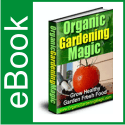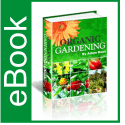Why Grow Your Own Vegetable Garden
Why Grow Your Own Vegetable Garden
Article by Derek Epperson
Nurturing your own vegetable garden is the perfect way to seize control over the fresh foods you use in your home. Spring and summer are primary planting seasons, and the do-it-yourself projects can help save your household money. And obviously, you do not have to be a gourmet eater to recognize the advantages of using organic items from your own garden.
Before you setup your own vegetable garden, you should consider a few of the following questions:
What’s the best way to start your own vegetable garden?Start small, with perhaps fresh salad greens and herbs. As you learn more, expand into other vegetables. Don’t be afraid to experiment-even if it doesn’t work out; you’ll soon learn from your mistakes.
What kind of space is needed to setup a vegetable garden?You can use containers on your deck if you don’t have a backyard to dedicate to growing your own vegetable garden. There are even types of vegetables developed for growing in containers.
What are some easy vegetables to grow?Some of the easiest are lettuce, beans, cucumbers, squash, radishes, scallions, chard, and herbs such as cilantro, parsley, and chives. All of these can be grown directly in your garden from seed.
When is the best time of year to plant a vegetable garden?Although it’s tempting to rush out and plant a vegetable garden when the sun is shining and the frost has gone, be patient. Plants thrive when the soil has warmed through and the night temperature doesn’t fall below 50 degrees Fahrenheit.
How do I prepare the soil before planting?The best way is to work several inches of organic material into your garden soil to improve its balance, texture, and water-holding capacity. Use aged manure, rotted leaves, peat moss, compost (the most effective option) or whatever’s available. Good soil is essential to having a productive garden.
How much watering will I need to do?Determining how much to water a vegetable garden highly depends on climates for your region. Ideally, one keeps the soil evenly moist, but not soggy. Mulching plants to conserve moisture is a good strategy in dry and hot areas. For areas with low summer rain, having drip irrigation is a good solution. Generally, if you put your finger in the soil and it feels dry up to your first knuckle, watering is probably needed. Plants growing in containers will need more water as they dry out more quickly.
How do I know when my vegetables are ready to pick?Use all your senses: Tap and smell melons, pull back corn husks to check the appearance of the kernels, and open a pod to look for perfectly plump peas. As with other aspects of gardening, recognizing perfect ripeness is more an art than a science, so don’t be afraid to make mistakes-That’s how you’ll learn. One thing to remember: Generally, vegetables are best harvested in the cool morning hours, before they’ve lost moisture in the midday heat. This will help them stay crisp and keep longer.
About the Author
To learn more about setting up your own vegetable garden, and reap the benefits of healthy food and saving money, check out this Growing Your Own Vegetable Garden. I wish you all the best with your vegetable garden planning.
Use and distribution of this article is subject to our Publisher Guidelines
whereby the original author’s information and copyright must be included.

 September 19, 2012
September 19, 2012 







